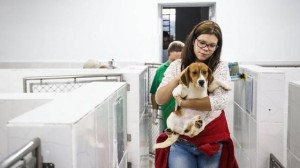Brazilians Occupying Research Lab Ignite National Debate on Animal Testing
ANIMAL RIGHTS - VEGETARIANISM, 4 Nov 2013
Antonio Pasolini, Occupy – TRANSCEND Media Service
October 18, 2013, was a landmark in the history of Brazil’s animal rights movement. In the early hours of that Friday, more than 100 animal rights activists occupied Instituto Royal in São Roque, located in São Paulo State, a laboratory that specializes in performing tests on animals for companies in the cosmetics and medical fields. During the occupation, 178 beagles were rescued from the lab as well as a few rabbits. Mice were about to be taken, too, but police arrived and stopped the rescue operation.
Saving lives destined for what activists say was never-ending torture at the hands of Big Pharma’s state-funded researchers was good enough reason to celebrate. But the media extravaganza that followed surpassed even animal advocates’ wildest dreams.
It all started one week earlier, when three female activists chained themselves to the gates of Instituto Royal. The women probably did not anticipate that their action would become a national sensation — a kind of “Arab Spring” for animal lovers in Brazil.
Since the beagle rescue took place, the topic of animal experimentation has been in the news on a daily basis, covered by virtually all of the most watched TV programs in Brazil as well as countless inches of print and online coverage. What’s more captivating still is the way public sentiment in these weeks has become visibly positive in favor of animals.
Once again, social media played a key role galvanizing the protest. The hashtags #ocupasaoroque, in reference to the laboratory town, and #institutoroyal became trending topics on Twitter, while Facebook was abuzz with posts about the occupation of the lab.
On Thursday evening, October 17, high profile activists such as TV presenter Luisa Mell and others headed toward the laboratory for a meeting with lab representatives. Upon arriving, the activists found out that the meeting was never actually meant to happen. As the deception became clear, they started posting updates on Facebook that attracted scores of people to the laboratory. Among the updates were reports of agonizing screams, raising suspicions that the laboratory was killing off evidence of mistreatment of the very animals for which they were supposed to be under investigation by public prosecutors.
In those early hours, “black blocs” joined the protest and led the occupation of the building — something that had not been planned. Occupiers carried out animals and documents to furnish the case against the lab.
The next day, the media was flooded with images of fragile, listless beagles in the arms of their rescuers. The images struck a chord with a large portion of Brazilian society. Immediately, a page was created on Facebook to find homes for the dogs, while not revealing the identities of the people who agreed to care for them. The page has already scored some 388,000 Likes and has become a popular barometer for the unfolding animal rights activism.
From that Friday onwards, nationwide commotion ensued. All major media outlets were reporting on the case and a new protest was scheduled for Saturday, October 19, which saw a turnout of around 1,000 people. As has become routine in Brazil, police attacked the peaceful demonstrators with teargas and pepper spray, including the elderly and children. Black blocs showed up again and burnt two police cars and a vehicle belonging to Rede Globo, the most heavily criticized corporate media outlet in Brazil. Globo is often accused of distortion and conservative views, seen by many as the Brazilian equivalent of Fox News.
The following week, the debate continued and Instituto Royal, which receives R$5 million (US$2 million) per year in federal funding, activated its PR machine in an attempt to portray activists as emotional lunatics. It said that important cancer research had been lost, even though it never mentioned exactly what type of research, and it omitted the research being done for cosmetics. A leaked paper also showed the institute had been operating illegally for 10 years without proper accreditation from CONCEA, the government body that regulates animal testing.
Meanwhile, Brazil’s National Agency of Health Supervision, or ANVISA, issued a note saying that labs must use humane alternatives to animal testing and that the agency would not be responsible for the validation of those tests, but rather it would be assigned to various ethics committees. The animal welfare arm of Brazil’s Bar association, OAB, also issued a note saying that the state in which the animals were found qualifies as animal abuse.
Last week, activists returned to Instituto Royal to hold a vigil and to try to negotiate with lab managers for the rescue of the remaining animals. Meanwhile, newspapers ran opinion polls as public audiences held discussion forums on animal experimentation in Brazil, planting the issue center stage.
Finally, on October 25, after an audience held between lawmakers, activists and local authorities, the City of São Roque announced it had suspended Instituto Royal’s license to operate for 60 days. The move was welcomed by Brazilian activists as a partial victory, since their objective was to close down the lab for good. During this period, the charges of animal abuse will be investigated by police.
Fabio Chaves, a prominent Brazilian animal rights activist who runs a popular social network website called Vista-Se, was one of those still camping out at Instituto Royal after the occupation. He kept a live blog from there on his website, which became a source of information for mainstream journalists.
“I believe the discussion will carry on,” he said. “Media outlets have reported that representatives are voting [on] animal-related projects that had been stagnant for years,” he said, calling the Instituto Royal episode “a watershed moment for animal rights all over the world.”
“It showed society no longer tolerates animal testing,” he added, “and the excuses given by scientists who say there are no alternatives.”
DISCLAIMER: The statements, views and opinions expressed in pieces republished here are solely those of the authors and do not necessarily represent those of TMS. In accordance with title 17 U.S.C. section 107, this material is distributed without profit to those who have expressed a prior interest in receiving the included information for research and educational purposes. TMS has no affiliation whatsoever with the originator of this article nor is TMS endorsed or sponsored by the originator. “GO TO ORIGINAL” links are provided as a convenience to our readers and allow for verification of authenticity. However, as originating pages are often updated by their originating host sites, the versions posted may not match the versions our readers view when clicking the “GO TO ORIGINAL” links. This site contains copyrighted material the use of which has not always been specifically authorized by the copyright owner. We are making such material available in our efforts to advance understanding of environmental, political, human rights, economic, democracy, scientific, and social justice issues, etc. We believe this constitutes a ‘fair use’ of any such copyrighted material as provided for in section 107 of the US Copyright Law. In accordance with Title 17 U.S.C. Section 107, the material on this site is distributed without profit to those who have expressed a prior interest in receiving the included information for research and educational purposes. For more information go to: http://www.law.cornell.edu/uscode/17/107.shtml. If you wish to use copyrighted material from this site for purposes of your own that go beyond ‘fair use’, you must obtain permission from the copyright owner.
Read more
Click here to go to the current weekly digest or pick another article:
ANIMAL RIGHTS - VEGETARIANISM:


